Fish Species of Lake Constance
Today 36 fish species of fish are counted in Lake Constance. These include species to be found in the river mouths, as well as non-domestic species, e.g. punmkinseed, imported from North America. Of these 36 species only about 50% are relevant for the fishing industry. Most important is the whitefish, followed by the perch, pike-perch, pike, European eel and cyprinids. Depending on the season, the fish are to be found in different depths of the lake. While some stay in the top most layers of the lake during summer time, they are retreating to greater depths during the winter months. Most species colonize the littoral zone during spring and summer months, preferring the warm water there. Other species such as whitefish, char and migratory brown trout prefer the cooler pelagic zone.
The largest variety in species is given by the group of the cyprinids. This group consists of carp-like fish, varying in size, shape and demands on their habitat. Some of those species such as freshwater bream or roach have a negative image due to their bony meat. Though the meat of these fishes is very tasty. Meanwhile special tools are in use, that enable removing even the smallest fish bones from the filet.
Whitefish (Coregonus sp.)
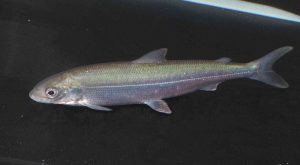
Of the 4 original whitefish species that inhabit Lake Constance the Kilch was considered extinct during the eutrophic phase of the lake. The other 3 species, the “Blaufelchen” (Coregonus wartmanni), “Gangfisch” (Coregonus macrophthalmus) and “Sandfelchen” (Coregonus nasus) mainly inhabit the pelagic, but sometimes also remain in littoral zones, where they feed on zooplankton and benthos. Spawning season ranges from the beginning until the middle of December. The”Blaufelchen” (Coregonus wartmanni) is of greatest interest for professional fishery.
Arctic char (Salvelinus umbla)
The Arctic char (Salvelinus umbla) prefers to stay in the cool pelagic zone. Young individuals feed on zooplankton, small crabs, and insect larvae. The diet of adult arctic char also include other fish. During spawning season in November, the char utilizes gravelly substrates to lay their eggs at spawning sites. During mating season in November, the male char is especially colorful. After a temporary recovery of the population, it rapidly declined along with the increasing population of the three-spined stickleback. The char is characterized by its pink and tasty meat.
Migratory brown trout (Salmo trutta)

The migratory brown trout spends most of its life in the lake. Only during breeding season, it migrates to the tributary waters of Lake Constance. Doing so, the adult fish (reaching weights up to 20 kg) master long distances upstream. The migratory brown trout is a typical predator, that mainly feeds on other fish, such as perch, cyprinids and whitefish or on insects as a juvenile. After a dramatic reduction of the population had been observed in the 1950ies, it has recovered in the meantime, by means of various efforts, such as adapted stocking management and unobstructed migration into the rivers. The species is relevant for professional as well as for recreational fishery.
Pike (Esox lucius)
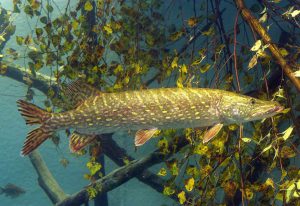
The pike is a large predator that mainly feeds on other fish. It predominantly stays close to the shore. Breeding time is in early spring. For recreational fishery the pike is an attractive fish that can be caught near shore but also in pelagic waters. Pike can undergo major population fluctuations. Because of its importance in the life cycle of fish parasites, managers try to keep its population as low as possible. To this end, the closed season and minimal length for the pike were eliminated in 1999. Nonetheless, yields have been continuously increasing due to improved water quality.
Pike-perch (Sander lucioperca)
The pike-perch is a typical predator living mainly in the open water. Originally his habitat was exclusively restricted to the catchment area of the Danube. Its immigration into Lake Constance is a consequence of stocking at the end of the 19. Century. In spring the pike-perch migrates to the shallow water for breeding where the eggs are watched by the male. Its significance in professional fishery has increased during the past years.
European perch (Perca fluviatilis)

During the vegetation period the perch mainly live in the shallow waters. The females lay their eggs in May. Juveniles mainly feed on Zooplankton (small crustaceans) and insect larvae. Larger specimens are piscivorous – they mostly eat juveniles of their own. During the decades of eutrophication (1970s to 1990s), the perch was the second most economically important fish after the whitefish.
Burbot (Lota lota)
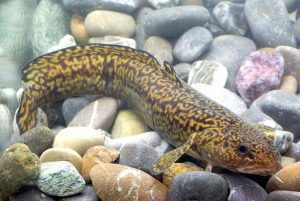
Burbot is the only freshwater-species of codfish. It predominantly inhabits the deeper regions of the lake and mainly feeds on benthic organisms and on young fish. Reproduction takes place during the cold winter months from January till March, when major accumulations of spawning burbot are quite common in greater depths. The burbots importance for fishing industry is greatest in the eastern part of Lake Constance. In gastronomy they are desirable, because of their tasty meat without any fish bones and last but not least: because of their large liver.
Roach (Rutilus rutilus)
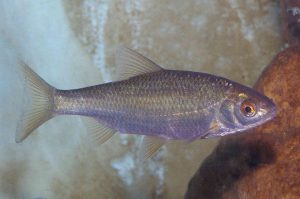
The roach belongs to the group cyprinids fish and predominantly inhabits the littoral area of Lake Constance. It feeds on benthic organisms as well as on zooplankton (small crustaceans). Roaches form large spawning gatherings in the shallow water in spring (April/May). Due to its bony flesh, the roach is undesirable and is of minor importance for the Lake Constance fishery. Some fisherman, however, have started targeted fishing, processing, and marketing of cyprinids fishes, and they have already won prizes with these products.
Freshwater bream (Abramis brama)

The freshwater bream is a typical representative of the cyprinids and predominantly stays in the littoral area. It feeds on zooplankton (crustaceans) and benthic organisms such as snails, worms and insect larvae. In spring, the freshwater bream needs suitable spawning substrates such as reeds or aquatic plants in order to breed. Stock development is declining due to reduced nutrient levels in the lake.
Crucian carp (Carassius carassius)
The crucian carp in Lake Constance is relatively seldom compared to other cyprinids such as roach or freshwater bream. It is mainly found in the littoral zone.
Common Carp (Cyprinus carpio)
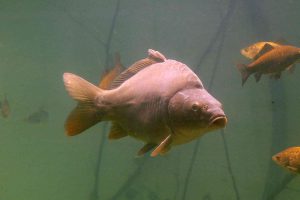
The preferred habitat of the common carp is the littoral zone, and it mainly feeds on benthic organisms. The common carp breeds very successfully in climatic favorable years. The very hot and dry summer of 2003 was conducive to common carp reproduction, leading to high carp stocks and yields in the following years.
Rudd (Scardinius erythrophthalmus)
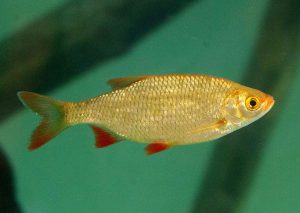
The rudd is a rare representative of the cyprinids in Lake Constance. It is particularly well-suited to plant-rich littoral zones.
Tench (Tinca tinca)
The tench population is rather low in Lake Constance. Its preferred habitat is a plant-rich area, where it seeks for food.
Bleak (Alburnus alburnus)
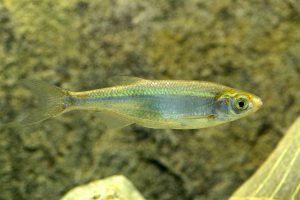
The bleak is a small-scale cyprinid that swarms in littoral zones. It predominantly feeds on zooplankton and spawns in the spring on shallow, gritty zones along the shore.
White bream (Blicca bjoerkna)
The white bream is a typical representative of the cyprinids and is mainly found in corresponding habitats near shore. Its population in Lake Constance is rather small.
European eel (Anguilla anguilla)
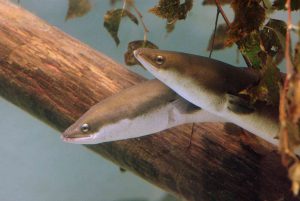
The European eel is a nocturnal species, which prefers to stay in littoral zones but occasionally enters the pelagic zone. Its population in Lake Constance is maintained by stocking measures because their natural migration from the Rhine via the Rhine falls near Schaffhausen is probably very limited. While the younger animals mainly feed on benthic creatures, the larger eels mainly predate other fish. The European eel is a coveted fish for human consumption, mainly on the German side of the lake. On the IUCN List of Threatened Species, the European eel is listed as critically endangered.
Wels catfish (Siluris glanis)
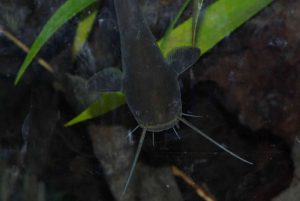
The Wels catfish is the largest indigenous predator, which hides under roots or between aquatic plants during daytime and preys at nighttime. It feeds mainly on other fish species and can reach a length of up to 2 m. While it has been relatively rare in the past, it has become more common in recent years, which is also reflected in the increasing catch statistics. This is, at least partly, attributed to global warming, as the catfish needs high water temperatures in late spring for successful reproduction.
Bullhead (Cottus gobio)
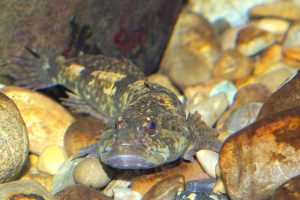
This small fish species, which is mainly hiding under stones in the littoral zone, mainly feeds on benthic creatures but also on juvenile fish and fish spawn. Due to its high demands on water quality, substrate and oxygen content, it is a good indicator of a corresponding water quality. The bullhead lays its eggs under stones in early spring. While in the years of eutrophication it had suffered severely due to reduced water quality, its population seems to have recovered in recent years.
Eurasian minnow (Phoxinus phoxinus)
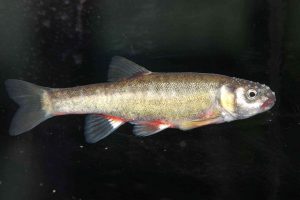
The Eurasian minnow is a carp-like small fish species which inhabits the shallow littoral zones. Its spawning season is in spring and it feeds on zooplankton and benthic organisms. The Eurasian minnow is an indicator of oxygen-rich water and a good water quality. Due to eutrophication, the population of the Eurasian minnow has decreased significantly. In the meantime, it is very rare in the Lake Constance and is almost exclusively found in the areas of river mouth.
Grayling (Thymallus thymallus)

The grayling a typical river fish. In Lake Constance it might enter riparian areas.
Common nase (Chondrostoma nasus)
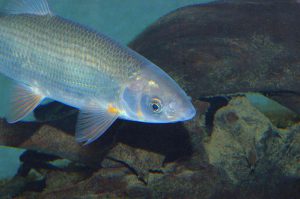
The common nase is a typical river fish that lives in larger streams. In Lake Constance it is found at best in a river mouth. New genetic studies reveal that the common nase of the “Alpenrhein”-Lake Constance catchment area significantly differs from the common nase upstream of the Rhine Falls. The common nase in Lake Constance only exists in residual stocks of a few hundred individuals in tributaries – it is threatened by extinction. The migratory fish working group currently addresses this species intensively.
Barbel (Barbatula barbatula)
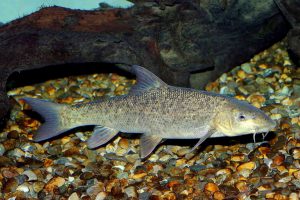
The barbel is a typical river fish and occasionally occurs in Lake Constance near a river mouth. As a ground fish, it is well equipped with a barbels-footed mouth to absorb benthic organisms such as snails, mussels and worms. To spawn in spring, it looks for gritty areas in the tributaries.
Chub (Leuciscus cephalus)
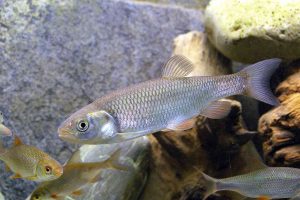
Concerning habitat requirements, the chub is a very indifferent representative of the cyprinids. It occurs in both rivers and lakes. In Lake Constance, it predominantly inhabits the littoral zones, in which it preys on benthic organisms and other fish. Due to its moderate stock density, the chub has no significance to the fishing industry.
Gudgeon (Gobio gobio)
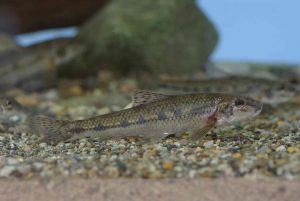
The gudgeon is a small fish species which is mostly found in littoral zones between stones and other structures.
Stone loach (Barbatula barbatula)
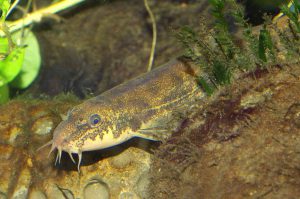
The stone loach is a common fish species in Lake Constance. It is mainly found in shallow waters between stones and other structures. it is mainly feeds on benthic organisms.
Common dace (Leuciscus leuciscus)
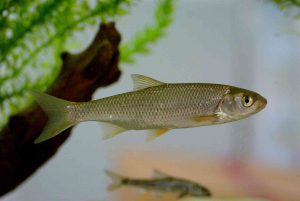
The common dace as a representative of the cyprinids is adaptive to different habitats. The species is found in lakes as well as in rivers. Shallow waters of the lake as well as river mouth areas are suitable breeding sites. In spring the fish gather in these areas for reproduction. The common dace mainly feeds on benthic organisms.
Alien Fish Species
The introduction of alien fish species has brought major changes to fish and crayfish species composition. The ruffe (Gymnocephalus cernuus), the three-spined stickleback (Gasterosteus aculeatus) and the spinycheek crayfish (Orconectes limosus) are just some examples. They all altered the food web of Lake Constance dramatically. Link to ANEBO
Ruffe (Gymnocephalus cernua)
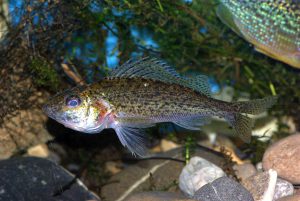
The ruffe was discovered for the first time in Lake Constance in 1987 . The species spread out over the lake and was the most common species in littoral zones. During the last few years its population seems to decrease again. The species is of no interest for the fishery.
Three-spined stickleback (Gasterosteus aculeatus)
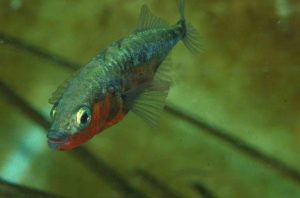
Originally the three-spine stickleback was not represented in Lake Constance. Most probably it was released to Lake Constance by uncontrolled disposal of aquarium fish. It successfully spread to the entire Lake in the 1960s. Since 2013 it is observed to occur in large numbers in the pelagic zone of the lake. This species shows a unique behavior during mating season in spring. The male builds a nest of plants and algae in the littoral zone. It then attracts the female with specific swimming patterns. The male takes care of the brood while the female leaves the nest after egg deposition.
Rainbow trout (Oncorhynchus mykiss)
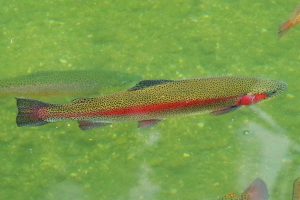
The rainbow trout was introduced to Europe at the end of the penultimate century as an alien species from North America. Although rainbow trout has not been stocked for a long time anymore the population remains constant in the lake. Since the rainbow trout breeds successfully in the Alpine Rhine and its tributaries, they probably sustain the Lake Constance rainbow trout population.
